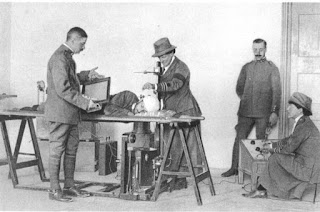Flora Sandes was the only English woman to serve in the Serbian army. The following was taken from pages 34-35 of her memoir, Autobiography of a Woman Soldier. Her recent biography, A Fine Brother, puts this day at October 20, 1916.
"One day Miladin and I were lying
together side by side behind a little rock about as big as a portmanteau,
within a few yards of the Bulgars, whilst the rest of our vod were scattered
behind nearby rocks. The Bulgars were behind a sort of natural fortification
immediately above us, which we had taken once, and had been driven out of the
same morning, at dawn, by a counterattack. We were sick at heart, and burning
to retake it. We lay there till late in the afternoon, motionless, peering
round the edige of rocks and firing a few shots and the fancy took us to keep
the enemy from making a sortie and bombing us. From force of habit we talked in
whispers as if we were stalking game, though the Bulgars must have been acutely
aware of our proximity.
We were hungry, having had nothing at all
since supper the previous night, and so wet and cold that the only thing I could
think of to keep up my spirits and while away the time, was to repeat the 'Charge of the Light Brigade,' which, as a child, I thought the most wonderful
poem in the world. Over and over at intervals I repeated it to myself, though
accepting for the fact of being 'in the mouth of hell', there wasn't much in
the poem that would fit our case."
From Autobiography of a Woman Soldier, page 34-35. A full-length biography of Flora Sandes, titled A Fine Brother, was written recently.
Her story is also included in the young adult collective biography, Women Heroes of World War I.
























